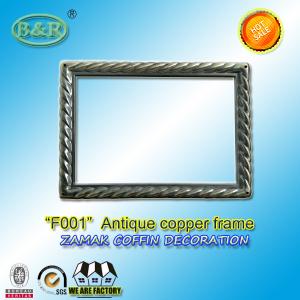

Add to Cart
Main information:
Product name:ZAMAK FRAME
Model: F001
Brand: B&R
Application: FUNERAL DECORATION
Origin: China
Manufacturer: Sumer International (Beijing) Trading Co.,Ltd
Product detail:
Size: 12*16.5 cm
Material: Zamak (Zinc alloy)
Color: Gold, Silver or Bronze (Optional)
Attached on coffin by screw
MOQ:1000 pcs
Main feature:
Professionally engaged in funeral field over 10 years;
Customized products acceptable;
Good quality and competitive price;
More Information:
Zinc Deposits
Zinc ore deposits are widely spread throughout the world. Zinc ores
are extracted in more than 50 countries. Australia, Canada, China,
India, Peru and Europe are the largest producers. Zinc is normally
associated with lead and other metals including copper, gold and
silver. There are four major types of zinc deposits:
1. Volcanic hosted massive sulfides (VMS)
VHMS deposits are polymetallic and are an important economic source
of copper and zinc often associated with significant concentrations
of silver, gold, cadmium, bismuth or tin.
2. Carbonate hosted (Mississippi Valley & Irish types)
Limestone and dolomite are the most common host rocks. The zinc
lead content usually ranges from 5%-10% with zinc usually
predominating over lead. Concentrations of copper, silver and
barite of fluorite may also be present.
3. Sediment hosted (sedex deposits)
The host rocks are mainly shale, siltstone, and sandstone. Sedex
deposits represent some of the world’s largest accumulations of
zinc, lead and silver. The mineral has a high silver content. The
lead/zinc content ranges from 10-20%.
4. Intrusion related (high sulfidation, skarn, manto, vein)
These deposits are typically found in carbonate rocks in
conjunction with magmatic-hydrothermal systems and are
characterized by mineral association of calcium and magnesium.
Typically the ore body contains more lead than zinc and is
associated with silver.
Zinc Minerals
The most commonly found zinc mineral is sphalerite (ZnS) also known
as zinc blende, which is found in almost all currently mined zinc
deposits. The mineral crystallizes from the hydrothermal solution
as pure zinc sulfide.
The mineral marmatite is a complex zinc-iron sulfide, which is
commonly found but rarely exploited, as it is not easy to smelt.
Zinc deposits close to the earth’s surface are often converted to
oxides and carbonates. Small quantities of zinc carbonate – the
mineral calamine (smithsonite) in North America – often refer to
the hydrated silicate mineral also known as hemimorphite.
Iron and lead sulfides, in the form of the minerals pyrite and
galena are always associated in significant quantities while
smaller quantities of other metals are commonly found.
Metamorphically formed oxide zinc ores such as franklinite or
zincite are limited to only a few deposits.
Zinc is a natural component of the earth’s crust and an inherent
part of our environment. Zinc is present in rock, soil, air, and
water. Plants, animals and humans also contain zinc.
The average natural level of zinc in the earth’s crust is 70 mg/kg
(dry weight), ranging between 10 and 300 mg/kg (Malle 1992).
In some areas, zinc has been concentrated to much higher levels by
natural geological and geochemical processes (5-15% or
50,000-150,000 mg/kg). Such concentrations, found at the earth’s
surface and underground, are being exploited as ore bodies.
Zamak 5 composition per standard
Zamak 5 has the same composition as zamak 3 with the addition of 1% copper in order to increase strength (by approximately 10%), hardness and corrosive resistance, but reduces ductility.It also has less dimensional accuracy.Zamak 5 is more commonly used in Europe.
Zamak 5 properties
| Property | Metric value | Imperial value |
| Mechanical properties | ||
| Ultimate tensile strength | 331 MPa (270 MPa aged) | 48,000 psi (39,000 psi aged) |
| Yield strength (0.2% offset) | 295 MPa | 43,000 psi |
| Impact strength | 52 J (56 J aged) | 38 ft-lbf (41 ft-lbf aged) |
| Elongation at Fmax | 2% | |
| Elongation at fracture | 3.6% (13% aged) | |
| Shear strength | 262 MPa | 38,000 psi |
| Compressive yield strength | 600 MPa | 87,000 psi |
| Fatigue strength (reverse bending 5x108 cycles) | 57 MPa | 8,300 psi |
| Hardness | 91 Brinell | |
| Modulus of elasticity | 96 GPa | 14,000,000 psi |
| Physical properties | ||
| Solidification range (melting range) | 380—386 °C | 716—727 °F |
| Density | 6.7 kg/dm3 | 0.24 lb/in3 |
| Coefficient of thermal expansion | 27.4 μm/m-°C | 15.2 μin/in-°F |
| Thermal conductivity | 109 W/mK | 756 BTU-in/hr-ft2-°F |
| Electrical resistivity | 6.54 μΩ-cm at 20 °C | 2.57 μΩ-in at 68 °F |
| Latent heat (heat of fusion) | 110 J/g | 4.7x10−5 BTU/lb |
| Specific heat capacity | 419 J/kg-°C | 0.100 BTU/lb-°F |
| Coefficient of friction | 0.08 | |
More Picture:
Antique bronze color
F001 zamak frame gold color
ZAMAK DECORATION
Crosses
